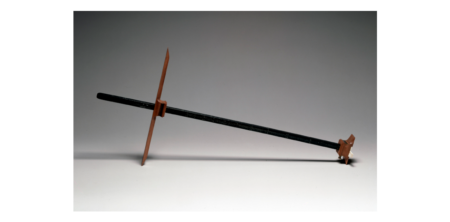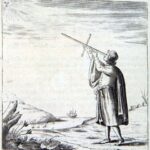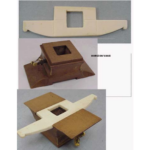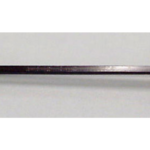Cross-Staff
Tool
Ancient
Quick Facts:
The cross-staff is an early navigational tool used to measure altitude or the distance of an object above sea level or the horizon
Introduction
The cross-staff was a navigational tool used to measure the angle between the horizon and a celestial body such as the sun or stars. By knowing this angle, a navigator could then determine his latitude and direction. The cross-staff is also referred to as the fore-staff and the Jacob’s staff. Thomas Hood suggested that the name Jacob’s staff came from the Biblical character Jacob in the book of Genesis. In one place, Genesis mentioned Jacob crossed the Jordan River using a staff; another reference tells of Jacob’s dream of a ladder between heaven and earth.1 The cross-staff was used for centuries until newer tools such as the back-staff became more widely used.
History
The principle of the cross-staff dates back to the Chaldeans, an ancient people of Mesopotamia (present day Iraq) around 400 BCE.2 The invention of the traditional cross-staff for use at sea was inspired by the kamal, a navigational tool often used by the Arabs during the medieval period. The angle of the sun or star above the horizon was measured by using a piece on the cross-staff called the transom. Early descriptions of the cross-staff date back to 11th century Persia.3 As trade between Europe and Asia grew, new ideas were brought back to Europe, and became popular there. While the concept of the cross-staff was known by the 15th century, it was not until the 16th century that the tool became more widely used. Historians found that earliest use of the cross-staff at sea came from the Portuguese around 1515.4 From here, it spread into Northern Europe. In 1571, English mathematician William Bourne printed a description on how the cross-staff could be used to measure the sun’s altitude.5
The cross-staff gets its name from its look and shape. It was typically made of wood. It was about 3 feet (36 inches) long with four different sized movable crosspieces.6 A navigator would hold it near his eye, and take measurements to determine altitude. By knowing the altitude, the navigator could then determine latitude and, eventually, longitude. But the cross-staff had its challenges. For one this, using it to sight the sun would be dangerous to the user’s eye. Navigators and sailors who used the cross-staff and similar tools could lose their eyesight from staring at the sun. Also, use of the cross-staff required the observer to look at two places at once – the bottom of the staff on the horizon, and the top part for the celestial body.7 The cross-staff was used into the 17th and 18th centuries. By 1750, the octant was the preferred tool for measuring altitude. Therefore, the cross-staff became less popular, and use of this tool eventually diminished.8
How It Works
The sides of the cross-staff were usually marked with degree scales up to 90o, 60o, 30o, and 10o. These helped you determine your angle. The user would also have four crosspieces of varying lengths. Although you had four crosspieces, navigators would typically use only one at a time, based on the height of the angle being measured. These crosspieces are called “transoms,” and also measure angles up to 90o, 60o, 30o, and 10o.9 So how does it work?
The navigator placed one end of the main staff against his cheek, just below his eye to observe the sun, Polaris (the North Star) or another bright star. The transom is adjusted so that the top of it aligns with the celestial object, and the bottom edge touches the horizon. The altitude is determined by the point where the main staff between the transom matches the degree scale.10 From here, the navigator will use charts and maps to determine his latitude.
Endnotes
- Robert Bud and Deborah Jean Warner, eds., Instruments of Science: An Historical Encyclopedia (London: Garland Publishing, Inc., 1998), 159.
- Cynthia Clark Northrup, ed., Encyclopedia of World Trade: From Ancient Times to the Present: From Ancient Times to the Present, Volumes 1-4 (New York: Routledge, 2005), 252.
- Peter Ifland, Taking the Stars: Celestial Navigation from Argonauts to Astronauts (Malabar: Krieger Publishing Company, 1998), 7.
- Bud and Warner, Instruments of Science, 159.
- Bud and Warner, Instruments of Science, 159.
- Northrup, Encyclopedia of World Trade, 251.
- Ifland, Taking the Stars, 8.
- Bud and Warner, Instruments of Science, 159 – 160.
- Ifland, Taking the Stars, 7 – 8.
- Tony Crowley, The Lo-tech Navigator (New York: Sheridan House, Inc., 2004), 81.
Bibliography
Bud, Robert, and Deborah Jean Warner, eds. Instruments of Science: An Historical Encyclopedia. London: Garland Publishing, Inc., 1998.
Crowley,Tony. The Lo-tech Navigator. New York: Sheridan House, Inc., 2004.
Ifland, Peter. Taking the Stars: Celestial Navigation from Argonauts to Astronauts. Malabar: Krieger Publishing Company, 1998.
Northrup, Cynthia Clark , ed. Encyclopedia of World Trade: From Ancient Times to the Present: From Ancient Times to the Present, Volumes 1-4. New York: Routledge, 2005.
Gallery
- Cross-Staff, Peter Ifland Collection, The Mariners Museum, (1998)
- Cross-Staff horizon vane (courtesy The Mariners’ Museum catalog – 1999.0011.000001A)
- Nineteenth century Cross-Staff (courtesy The Mariners’ Museum catalog – 1999.0011.000001A)
Videos




